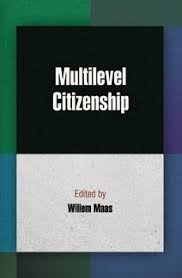Edited by Willem Maas, an authoritative voice on EU citizenship, the book’s goal is to transcend the often dreary discussions of European supranationality, examining instead multilevel citizenship in a wide geographical and historical framework.
Contributors to the eleven chapters of the volume agree that ‘citizenship literature has overlooked the fact that debates on political participation, membership, and nationality happen at multiple levels of decision making’ (Pedroza, p. 40), and that ‘multiple, overlapping sovereignties, the defining feature of multilevel citizenship, are as common in history as they are rare in political theory’ (Hanley, p. 90).
The volume proposes a variety of remedies to the above diagnosis. The first three chapters following the introduction focus on ‘migrants and migrations’. In Chapter 2, Luicy Pedroza looks at denizen enfranchisement by examining primary and secondary sources from 46 countries, and thus expanding the limited data generated so far by studies employing ‘the fashionable three-case comparison’ (p. 30). Chapters 3 and 4 both reflect the US experience. First, Rogers M. Smith reviews the recent history of state-level ‘attrition through enforcement’ policies, concluding that while such ‘bottom-up’ measures are legitimate, they bring to surface a conflict between the multiple levels on which citizenship is constructed in the United States, its resolution requiring the acceptance of ‘semi-sovereignty’ and ‘moderate’ forms of political peoplehood. Kinney and Cohen’s subsequent chapter places Smith’s observations within a wider framework. Their analysis of state-level immigration-related legislation between 2005 and 2011 confirms that along the federal government, US states are increasingly involved in matters of immigration enforcement, and that their approach towards immigration is heavily divided. As a result, ‘it is more desirable for noncitizens to live in some states rather than others’ (p. 84).
The second part of the book deals with ‘empires and indigeneity’. In Chapter 5, Will Hanley looks at ‘Ottoman-Egyptian nationality’, highlighting the deficiency of ‘conventional descriptive vocabularies’ (p. 90). He also emphasizes that in order to capture the complexity of citizenship in historical and extra-European contexts one must focus on ‘legal, economic, and even cultural practices’ instead of political rights (p. 90). A similar argument is put forward in Chapter 6, where Elizabeth Dale scrutinizes ‘everyday citizenship’ in China at the turn of the twentieth century. From a constitutional perspective, the author calls into question that citizenship is dependent on the existence of sovereignty, showing that even in ‘hypo-colonial’ settings ‘historical subjects could act in ways that helped define their citizenship and expand the possibilities of citizenship for others’ (pp.125-26). In Chapter 7 Sheryl Lightfoot invites readers back to North America, comparing Indigenous citizenship in Canada and the United States, in light of the emerging international Indigenous rights discourse. In line with the previous two chapters, Lightfoot sees multilevel citizenship arrangements as negotiated, evolving in time, and acquiring their special functions through practice.
The four chapters making up the third part of the book examine ‘local, multinational and postnational’ forms of citizenship. Following the presentation of the Swiss case, characterized by extreme decentralization (Marc Helbling, Chapter 8), and that of Bosnia and Herzegovina, a former Yugoslavian state (Eldar Sarajlid, Chapter 9), Türküler Isiksel draws a disquieting picture of ‘market citizenship’ as ‘a creeping takeover of the possibilities for democratic politics by market logic’ (p. 202). Finally, in the closing chapter Catherine Neveu revisits the ‘local’ from a French perspective, arguing that instead of focusing on ‘scales’ of citizenship, scholars should rather study ‘the “politics of scales” that underlie political mobilizations and projects’ (p. 212).
Collectively, the chapters offer powerful support to the concept of multilevel citizenship as a perennial form of political and legal membership, making the book a valuable reading especially for citizenship scholars already familiar with the basic tenets of the research field.
Besides advancing a novel point of view in the analysis of multilevel citizenship, the volume offers several examples of how yet unexplored empirical data sources can prove highly useful (in this respect, chapters 2, 4, 5 and 6 deserve singling out). However, the aim of the volume to broaden our understanding of the topic necessarily involves that the data and arguments of each chapter could only be fully explored in lengthier separate studies.
The editorial mastery deserves special mention, as despite the sheer variety of case studies the core question has not once become secondary. As noted in the preface, one motivation behind the book was to ‘demonstrate … that EU citizenship is not sui generis and incomparable with other forms of citizenship but rather the most compelling recent example of a form of multilevel citizenship that has historical precursors and is likely to develop further’ (p. vii). Indeed, this steady comparative frame is recurrently invoked in the individual chapters, and the full potential of the volume will be recognized by those readers genuinely intrigued by yet sceptical of EU citizenship.
Back to top